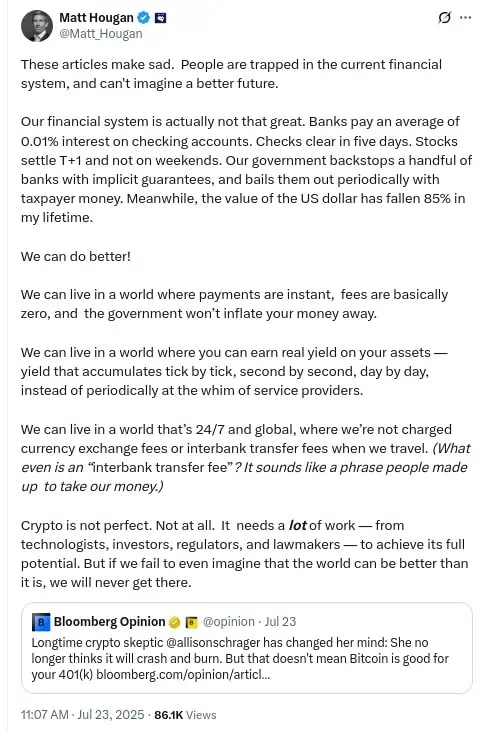
The global financial system is at a turning point, with cryptocurrencies emerging as an alternative that promises to transform the way we interact with money.
Matt Hougan, Chief Investment Officer at Bitwise, has articulated how blockchain technology and digital assets are laying the foundations for a fairer financial system, characterized by instant payments, real returns and technological transparency.
Hougan's vision contrasts with the inherent limitations of the traditional financial model, which presents inefficiencies and opacity that directly affect ordinary users.
BUY CRYPTOCURRENCIES ON BIT2METhe shortcomings of the current financial system
Hougan has identified several critical flaws in the conventional financial system. One of the most obvious is the slowness in the movement of moneyPayments and check clearing can take days to process, and stock market operations are not seamless. In his view, this inefficiency translates into a hindrance to economic agility and individuals' ability to access their funds in a timely manner.
Furthermore, the Interest rates on current accounts are negligible, in some cases as low as 0,01%, while banks lend the same money at much higher rates. This disparity generates a constant devaluation of the purchasing power of money due to inflation, a problem exacerbated by government support for large banks.
La opacity in monetary decision-making and bank bailouts, which are often carried out without public consultation or clarity, undermine public confidence in the traditional system.
According to Hougan, the value of the dollar has experienced a significant decline in recent decades, a clear indication of the impact of inflation and opaque monetary policies.

The three pillars of a cryptocurrency-powered financial system
Faced with these limitations, Hougan emphasizes that cryptocurrencies offer a viable solution, structured around three fundamental pillars:
Frictionless Payments: Speed as a Financial Right
One of the most attractive promises of cryptocurrencies is the ability to make payments frictionlessly and at unprecedented speedUnlike traditional systems, where checks can take five days to clear and stocks settle in T+1 (one business day after the transaction) without trading on weekends, cryptocurrencies allow 24/7 transactions, with no hidden fees or arbitrary commissions.
This new paradigm is embodied in the use of stablecoins, digital currencies whose value is pegged to a stable asset like the US dollar. Stablecoins enable global transfers in seconds, facilitating trade and remittances more efficiently and economically.
TRADE WITH STABLECOINSAppropriate regulation, such as that proposed by the GENIUS Act in the United States and the MiCA regulation in Europe, is accelerating the integration of these digital currencies into the mainstream economy. Regulatory clarity could even allow established banks like JPMorgan and Bank of America to issue their own stablecoins, further driving the mass adoption of these digital assets.
Hougan argues that The technology is now ready for a world where payments are instant and fees are almost zero.; what is needed is the institutional will to adopt it.
Real returns: money that generates constant value
In contrast to traditional savings accounts that offer ridiculous interest, the ecosystem of Cryptocurrencies allow assets to generate real returns, accumulated in real time, without relying on arbitrary cycles or excessive intermediaries, Hougan said. This is achieved through various decentralized finance (DeFi) platforms, which offer opportunities for users to earn daily, transparent interest on their digital assets.
Although the DeFi space still requires regulatory improvements, mechanisms already exist that allow users to earn consistent, fully traceable profits. This ability to generate constant value is a fundamental shift, as it empowers individuals to make their assets work for them, rather than seeing their purchasing power eroded by inflation and low bank interest rates.
The inherent volatility of many cryptocurrencies, such as Bitcoin, means their value can fluctuate significantly over short periods of time, underscoring the importance of understanding the risks associated with investing in these assets. However, the promise of real returns in the crypto ecosystem offers an attractive alternative for those looking to maximize the value of their assets.
Technological transparency: clear rules and distributed trust
The third pillar is the transparency inherent in blockchain technology. Unlike the traditional financial system, where crucial decisions are often made behind closed doors, Cryptocurrencies operate under rules written in open source, accessible to everyone.This enables automatic auditing of transactions, which fosters trust by eliminating the need to rely on centralized, opaque intermediaries.
Technological transparency also has a significant impact on financial inclusion. Regulated stablecoins, for example, could provide access to financial services to unbanked people around the world, using only a mobile phone.
Furthermore, the traceability of transactions on the blockchain offers considerable potential for combating money laundering and other illicit activities, without necessarily sacrificing user privacy.
TRADE WITH CONFIDENCE IN CRYPTO HEREWhile Hougan acknowledges that the crypto ecosystem is not perfect and still faces challenges, he insists that its inherent transparency positions it as the path to building a fairer and more equitable financial system for allHe believes that blockchain technology, as a general-purpose technology, has a wide range of future applications that will be deployed across different sectors, which could lead to varying long-term investment returns.
The future: smart regulation and institutional collaboration
Hougan's vision for a cryptocurrency-powered financial system is clear: the transformation is underway. But for this change to be successful and widespread, it requires smart regulation and active collaboration between traditional institutions and the crypto ecosystem. Legislation that provides clarity, such as that being developed in several jurisdictions, is crucial to allowing major financial institutions to fully participate in the cryptocurrency space.
This development could revolutionize the way transactions are conducted, making digital payments as common as everyday debit or credit transactions.
The normalization of stablecoin use on blockchain networks is just the first step in a broader financial transformation, which could see more asset classes migrate to blockchain systems as confidence in digital currencies grows.
Hougan predicts that the impact of strong crypto regulation will resonate for years to come, catalyzing a new financial era. Thus, despite the inherent volatility of cryptocurrencies, the resilience of assets like Bitcoin and the rise in institutional interest suggest that digital assets are consolidating as a fundamental part of the global financial landscape.
BUY BITCOIN ON BIT2ME


